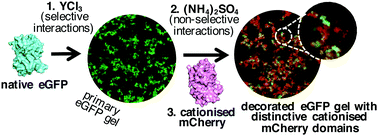Decorated networks of native proteins: nanomaterials with tunable mesoscopic domain size†
Abstract
Natural and artificial proteins with designer properties and functionalities offer unparalleled opportunity for functional nanoarchitectures formed through self-assembly. However, to exploit this potential we need to design the system such that assembly results in desired architecture forms while avoiding denaturation and therefore retaining protein functionality. Here we address this challenge with a model system of fluorescent proteins. By manipulating self-assembly using techniques inspired by soft matter where interactions between the components are controlled to yield the desired structure, we have developed a methodology to assemble networks of proteins of one species which we can decorate with another, whose coverage we can tune. Consequently, the interfaces between domains of each component can also be tuned, with potential applications for example in energy – or electron – transfer. Our model system of eGFP and mCherry with tuneable interactions reveals control over domain sizes in the resulting networks.



 Please wait while we load your content...
Please wait while we load your content...